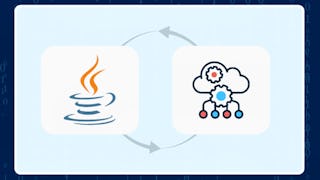This course teaches learners (industry professionals and students) the fundamental concepts of concurrent programming in the context of Java 8. Concurrent programming enables developers to efficiently and correctly mediate the use of shared resources in parallel programs. By the end of this course, you will learn how to use basic concurrency constructs in Java such as threads, locks, critical sections, atomic variables, isolation, actors, optimistic concurrency and concurrent collections, as well as their theoretical foundations (e.g., progress guarantees, deadlock, livelock, starvation, linearizability).



Concurrent Programming in Java
This course is part of Parallel, Concurrent, and Distributed Programming in Java Specialization

Instructor: Vivek Sarkar
26,106 already enrolled
Included with 
(663 reviews)
Skills you'll gain
Details to know

Add to your LinkedIn profile
4 assignments
See how employees at top companies are mastering in-demand skills

Build your subject-matter expertise
- Learn new concepts from industry experts
- Gain a foundational understanding of a subject or tool
- Develop job-relevant skills with hands-on projects
- Earn a shareable career certificate

There are 7 modules in this course
Welcome to Concurrent Programming in Java! This course is designed as a three-part series and covers a theme or body of knowledge through various video lectures, demonstrations, and coding projects.
What's included
1 video5 readings1 programming assignment1 discussion prompt
In this module, we will learn about threads and locks, which have served as primitive building blocks for concurrent programming for over five decades. All computing platforms today include some form of support for threads and locks, and make them available for use by developers in a wide range of programming languages. We will learn how threads can be created, joined, and synchronized using structured (e.g., synchronized statements/methods) and unstructured (e.g., java.util.concurrent libraries) locks in Java. We will also learn about new classes of bugs that can arise when concurrent programs need to access shared resources. These bugs are referred to as violations of liveness/progress guarantees, and include deadlock, livelock, and starvation. We will conclude this module by studying different solutions to the classical "Dining Philosophers" problem, and use these solutions to illustrate instances of deadlock, livelock and starvation.
What's included
6 videos6 readings1 assignment1 programming assignment
In this module, we will learn different approaches to coordinating accesses to shared resources without encountering the deadlock or livelock bugs studied earlier. Critical/isolated sections are higher-level concurrent programming constructs (relative to locks) that simplify the implementation of mutual exclusion by guaranteeing the absence of deadlocks and livelocks. Object-based isolation relaxes the constraints imposed by critical sections by allowing mutual exclusion to be specified on a per-object basis, as illustrated in the Spanning Tree example. Java's atomic variables represent an important, but restricted, case of object-based isolation that is implemented efficiently on all hardware platforms. Finally, we will learn how object-based isolation can be further relaxed with read/write access modes.
What's included
6 videos6 readings1 assignment1 programming assignment
Join Professor Vivek Sarkar as he talks with Software Engineer, Dr. Shams Imam, at their downtown Houston, Texas office about threads, locks, deadlocks, high-level and low-level constructs, and the importance of concurrent programming.
What's included
2 videos1 reading
In this module, we will learn another high-level approach to concurrent programming called the "Actor" model. A major difference between the Actor model and the Isolated Sections model is that there are no data races possible in the Actor model because it does not allow for any form of shared variables. However, as in all concurrent programming models, higher-level forms of nondeterminism are still possible in the Actor model due to an inherent asynchrony in the order in which messages may be delivered. We will study multiple examples of concurrency using the Actor model, including the classical Sieve of Eratosthenes algorithm to generate prime numbers, as well as producer-consumer patterns with both unbounded and bounded buffers.
What's included
6 videos6 readings1 assignment1 programming assignment
In this module, we will study Concurrent Data Structures, which form an essential software layer in all multithreaded programming systems. First, we will learn about Optimistic Concurrency, an important multithreaded pattern in which two threads can "optimistically" make progress on their assigned work without worrying about mutual conflicts, and only checking for conflicts before "committing" the results of their work. We will then study the widely-used Concurrent Queue data structure. Even though the APIs for using concurrent queues are very simple, their implementations using the Optimistic Concurrency model can be complex and error-prone. To that end, we will also learn the formal notion of Linearizability to better understand correctness requirements for concurrent data structures. We will then study Concurrent Hash Maps, another widely-used concurrent data structure. Finally, we discuss a concurrent algorithm for finding a Minimum Spanning Tree of an undirected graph, an algorithm that relies on the use of Concurrent Data Structures under the covers.
What's included
6 videos7 readings1 assignment1 programming assignment
The next two videos will showcase the importance of learning about Parallel Programming and Distributed Programming in Java. Professor Vivek Sarkar will speak with industry professionals at Two Sigma about how the topics of our other two courses are utilized in the field.
What's included
2 videos1 reading
Earn a career certificate
Add this credential to your LinkedIn profile, resume, or CV. Share it on social media and in your performance review.
Instructor

Offered by
Explore more from Software Development
 Status: Free Trial
Status: Free Trial
Rice University
 Status: Free Trial
Status: Free Trial
Board Infinity
 Status: Free Trial
Status: Free Trial
Rice University
Why people choose Coursera for their career




Learner reviews
663 reviews
- 5 stars
66.81%
- 4 stars
24.73%
- 3 stars
5.88%
- 2 stars
1.05%
- 1 star
1.50%
Showing 3 of 663
Reviewed on Sep 19, 2020
Very good explanation of the concepts of locks, and how important data-structures example HashMap are optimized to improve performance
Reviewed on Nov 26, 2020
It could have been better. Course content is very basic and just scratches the surface of concurrent programming. However, fully recommend it for beginners.
Reviewed on Apr 30, 2020
It was a really interesting course where the things were presented in a very simplified manner in which I could learn the topics in a short span of time.
New to Software Development? Start here.

Open new doors with Coursera Plus
Unlimited access to 10,000+ world-class courses, hands-on projects, and job-ready certificate programs - all included in your subscription
Advance your career with an online degree
Earn a degree from world-class universities - 100% online
Join over 3,400 global companies that choose Coursera for Business
Upskill your employees to excel in the digital economy
Frequently asked questions
Access to lectures and assignments depends on your type of enrollment. If you take a course in audit mode, you will be able to see most course materials for free. To access graded assignments and to earn a Certificate, you will need to purchase the Certificate experience, during or after your audit. If you don't see the audit option:
The course may not offer an audit option. You can try a Free Trial instead, or apply for Financial Aid.
The course may offer 'Full Course, No Certificate' instead. This option lets you see all course materials, submit required assessments, and get a final grade. This also means that you will not be able to purchase a Certificate experience.
When you enroll in the course, you get access to all of the courses in the Specialization, and you earn a certificate when you complete the work. Your electronic Certificate will be added to your Accomplishments page - from there, you can print your Certificate or add it to your LinkedIn profile. If you only want to read and view the course content, you can audit the course for free.
If you subscribed, you get a 7-day free trial during which you can cancel at no penalty. After that, we don’t give refunds, but you can cancel your subscription at any time. See our full refund policy.
More questions
Financial aid available,



